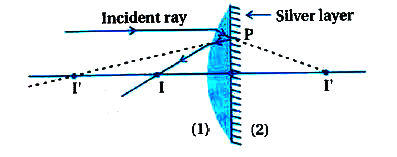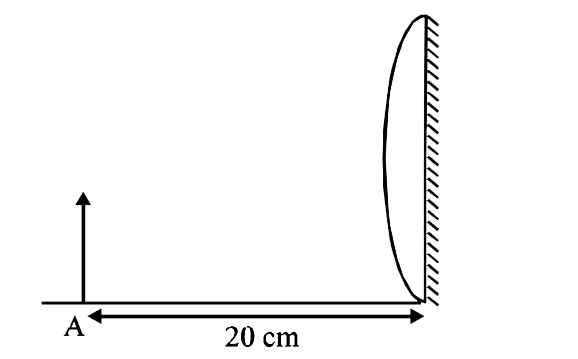As shown in figure, a plano-convex lens of focal length 20 cm is silvered at its plane surface and it is made reflecting, then find new focal length of system.
 Solution in Gujrati
Solution in Gujrati
20 cm
30 cm
40 cm
10 cm
The correct Answer is:A, C, D
By observing path of ray it is clear that before final image I is formed,
For first refraction from curved surface ∴1f1 then reflection from silvered plane surface ∴1FM and then second refraction from curved surface ∴1f1
where f1= focal length of plano convex lens = 20 cm
Fm= focal length of plane mirror =∞
Now, equivalent focal length, F can be obtained as follows.
1F=1f1[Plano convex lens]
+1FM [Plane mirror]
+1f1[Plano covex lens]
1F=2f1+1fm=220+1∞=110
∴F=10 cm
[Note that here f1 is positive. If it was concave f1 would be negative]
Topper's Solved these Questions
- RAY OPTICS AND OPTICAL INSTRUMENTSBOOK - KUMAR PRAKASHANCHAPTER - RAY OPTICS AND OPTICAL INSTRUMENTSEXERCISE - SECTION-D (MULTIPLE CHOICE QUESTIONS (MCQs))(MCQs FROM .DARPAN. BASED ON TEXTBOOK)(MCQs BASED ON TEXTUAL ILLUSTRATION AND EXERCISE)
24 Videos
- MOVING CHARGES AND MAGNETISMBOOK - KUMAR PRAKASHANCHAPTER - MOVING CHARGES AND MAGNETISMEXERCISE - SECTION D (MCQs ASKED IN COMPETITIVE EXAMS)
34 Videos
- SAMPLE QUESTION PAPER BOOK - KUMAR PRAKASHANCHAPTER - SAMPLE QUESTION PAPER EXERCISE - PART-B SECTION-C
5 Videos
Similar Questions
The earth takes 24 h to rotate once about its axis. How much time does the sun take to shift by 1° when viewed from the earth?
View SolutionElectric charge Q having mass M moves on a circular path of radius R with velocity →v, perpendicular to uniform magnetic field B. When a particle completes one revolution, work done by the field is _______
View SolutionTwo charges –q and +q are located at points (0, 0, –a) and (0, 0, a), respectively.
(a) What is the electrostatic potential at the points (0, 0, z) and (x, y, 0) ?
(b) Obtain the dependence of potential on the distance r of a point from the origin when r/a>>1 .
(c) How much work is done in moving a small test charge from the point (5,0,0) to (–7,0,0) along the x-axis? Does the answer change if the path of the test charge between the same points is not along the x-axis?
View SolutionFocal length of the plano-convex lens is 15 cm. A small object is placed at A as shown in the figure. The plane surface is silvered. The image will form at

View SolutionFocal length of the plano-convex lens is 15cm. A small object is placed at A as shown in figure. The plane surface is silvered. The image will form at
View SolutionA plano convex lens has focal length f=20cm. If its plane surface is silvered, then new focal length will be
View SolutionThe plane surface of a plano-convex lens of focal length f is silvered. It will behave as
View SolutionThe convex surface of a plano-convex lens is silvered and the radius of curvature of this surface is R. Find the focal length of the system:
View SolutionA plano convex lens has focal length f=20cm. If its plane surface is silvered, then new focal length will be
View SolutionIf the plane surface of a plano-convex lens of radius of curvature R and refractive index mu is silvered, then its focal length would be
View SolutionA plano-convex lens (f = 20 cm) is silvered at plane surface. Now focal length will be
View Solutionএকটি সমতল উত্তল লেন্সের ( f = 20 cm ) সমতল পৃষ্ঠে রূপার প্রলেপ দিলে ওর ফোকাস দৈর্ঘ্য হবে
View SolutionThe plane surface of a plano convex lens of focal length f is silvered. It will behave as a
View SolutionFocal length of the plano-convex lens is 15cm. A small object is placed at A as shown in figure. The plane surface is silvered. The image will form at
View SolutionIf the plane surface of a plano-convex lens of radius of curvature R and refractive index mu is silvered, then its focal length would be
View Solution
